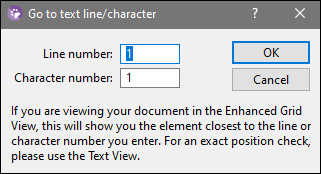View
The commands available in the View menu are described in the subsections below.
Text View and Grid View
The Text View command is available in File Comparison windows (not Directory Comparison or Database Data Comparison windows) and switches both files of the active File Comparison window to Text View. Note that both files are always displayed in the same view. To switch the view, you can also use the Text View tab of either pane; the tabs are located at the bottom of each pane.
The Grid View command is available in File Comparison windows (not Directory Comparison or Database Data Comparison windows) and switches both files of the active File Comparison window to Grid View. Note that both files are always displayed in the same view. To switch the view, you can also use the Grid View tab of either pane; the tabs are located at the bottom of each pane.
Toolbars
The Toolbars menu item contains a submenu with commands that show or hide the respective application toolbars.
Toolbar settings take effect depending on the current comparison mode. For example, if toolbar settings are made with a File Comparison window open, the settings apply to all File Comparison windows that are currently open and that will be opened subsequently. You can restore all toolbars to their default state by running the menu command Tools | Restore Toolbars and Windows.
The Customize submenu item is a shortcut for the Tools | Customize command.
Status Bar
The Status Bar, located at the bottom of the DiffDog application window, displays the following application-level information:
•A description of menu command and toolbar icon actions; displayed when the mouse cursor is placed over the command or icon. This information is on the left side in the Status Bar.
•Position of the cursor in a document, in terms of line number and character number (lower-right corner)
•Status of the Caps Lock, Num Lock and Scroll Lock keys (lower-right corner)
•If you are using the 64-bit version of DiffDog, this is indicated in the status bar with the suffix (x64) after the application name. There is no suffix for the 32-bit version.
You can toggle the Status Bar on and off using the Status Bar command in File Comparison, XML Schema Comparison, Directory Comparison, Database Data Comparison, and Database Schema Comparison windows.
Note: Do not confuse the Application Status Bar described here with the File Comparison and Directory Comparison Status Bars, which are located at the bottom of Comparison Windows and contain information about that comparison. Comparison Window status bars are described in the DiffDog Interface section.
Toggle 2-way/3-way Comparison (Enterprise Edition)
Switches the active comparison window from a two-pane comparison into a three-way comparison mode, and vice versa. For more information, see Three-Way Comparisons.
Synchronized Scrolling
The Synchronized Scrolling command opens a sub-menu, where you can set this option separately for horizontal and vertical scrolling.
Synchronized scrolling is available in File Comparison windows. If documents extend over a horizontal or vertical length greater than the size of its containing pane, horizontal and vertical scrollbars, respectively, appear at the bottom and right of the pane, respectively. When synchronized scrolling is enabled, both documents can be scrolled simultaneously so that corresponding sections of the two documents are displayed simultaneously.
If you scroll through one document (by moving the scrollbar, clicking the scroll arrows, or using the mouse wheel) when synchronized scrolling is toggled on, the document in the other pane will also scroll (horizontally or vertically) so that the corresponding part of the document is displayed.
Please note that synchronized scrolling is possible only after a file comparison has been carried out (since the correspondence of sections in the two documents can only be determined after a comparison is made).
Settings for synchronized scrolling apply to the application as a whole, and take effect immediately for all open File Comparison windows and subsequently opened File Comparison windows.
Note that this command is not available in Database Data Comparison and Database Data Comparison Result windows.
Go to line/char
The Go to line/char ![]() (Ctrl+G) feature is available in File Comparison windows only, and enables you to go to a particular location in the active document using line and character coordinates. The command pops up the Go to text line/character dialog (screenshot below).
(Ctrl+G) feature is available in File Comparison windows only, and enables you to go to a particular location in the active document using line and character coordinates. The command pops up the Go to text line/character dialog (screenshot below).

Enter the required line and character numbers in the respective text boxes, and click OK. This positions the cursor at the specified location.
Note: In Grid View, the Go to line/char feature highlights the grid cell closest to the line or character number you enter.
Note that this command is not available in Database Data Comparison and Database Data Comparison Result windows.